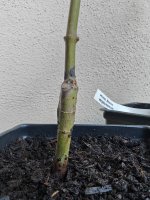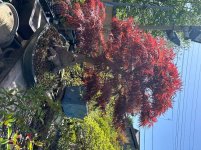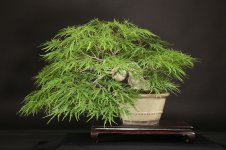Bonsai Babby
Yamadori
Hello,
I got the last of my two trees (for now) in the mail. They are Japanese Maple, Hime Shojo and Tamukayama, both are grafted.
My plan for the Hime Shojo is to just try to make it into a mini tree, not really go for dramatic trunk tapering etc.
For the Tamukayama, I want to do trunk chops and get a wild tapering trunk... these are what I envision. I don't know how to accomplish it but I am reading a lot and trying to learn.
I could also switch methods too if either tree looks like it won't be suitable for what I want.
First I have a question - can I scrape the bark and ground layer them below the graft line to get rid of the grafted area? Is that a bad or stupid idea?
If I just leave it, will the grafted area look nicer later? Or is it always gonna be a big bumpy spot? Here are pictures. My immediate plan is to move them to training pots and let them grow. If there is anything I should do differently that will help them develop into their final forms, I would be very grateful to hear any advice.
Hime Shojo:


Tamukeyama:


And here are the full pictures of each:

I got the last of my two trees (for now) in the mail. They are Japanese Maple, Hime Shojo and Tamukayama, both are grafted.
My plan for the Hime Shojo is to just try to make it into a mini tree, not really go for dramatic trunk tapering etc.
For the Tamukayama, I want to do trunk chops and get a wild tapering trunk... these are what I envision. I don't know how to accomplish it but I am reading a lot and trying to learn.
I could also switch methods too if either tree looks like it won't be suitable for what I want.
First I have a question - can I scrape the bark and ground layer them below the graft line to get rid of the grafted area? Is that a bad or stupid idea?
If I just leave it, will the grafted area look nicer later? Or is it always gonna be a big bumpy spot? Here are pictures. My immediate plan is to move them to training pots and let them grow. If there is anything I should do differently that will help them develop into their final forms, I would be very grateful to hear any advice.
Hime Shojo:


Tamukeyama:


And here are the full pictures of each:






